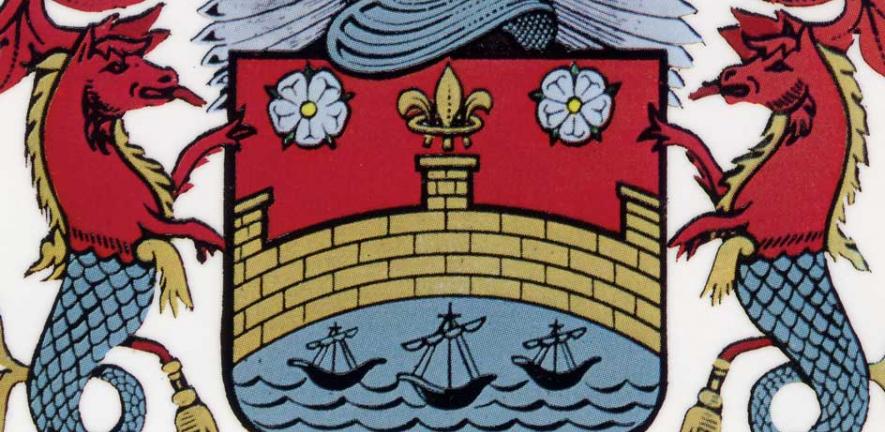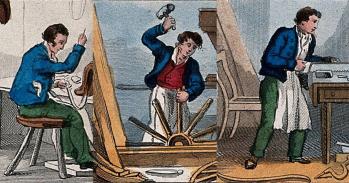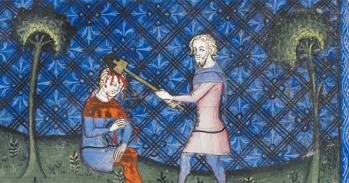
An Open Cambridge event will tell the fascinating story of Cambridge’s civic insignia and historic charters through 800 years of history.
An Open Cambridge event will tell the fascinating story of Cambridge’s civic insignia and historic charters through 800 years of history.
It’s a small miracle that we have the King Charles Mace today to remind us of a turbulent period in British history.
Chris Cracknell, Sergeant-at-Mace, Cambridge Mayoral Office
In 1575 the Borough of Cambridge received a charter from Queen Elizabeth 1 granting the town its own coat of arms. The original charter carrying the coat of arms, which brings together many of the elements that make Cambridge distinctive, is still in the safekeeping of the Guildhall.
Cambridge's coat of arms depicts a shield decorated by a bridge over a river with three sailing boats, their sails furled. The shield is topped by a castle and flanked by a pair of magnificent seahorses. Below the castle is a helmet from a suit of armour and above the bridge are two roses and a fleur-de-lis signifying Cambridge’s royal connections. It was granted following an application from the Mayor of Cambridge, Thomas Kimbold, and the request followed the granting of a coat of arms to the University two years earlier.
Along with an array of items telling the story of Cambridge as an important centre for local and regional government and an international seat of learning, the original 1575 charter will be shown to the public during a talk, The Civic Insignia and Historic Charters, at the Guildhall on Friday 7 September and Saturday, 8 September, 11am to 12.15pm. The talks are part of Open Cambridge, a programme of free public events taking place from 7 to 9 September.
The talk will be given by Chris Cracknell, who has been Sergeant-at-Mace in Cambridge’s Mayoral Office at Cambridge City Council for the past four years. His day-to-day work is to provide practical support to the Mayor in his or her engagements and ensure that the age-old traditions associated with the mayoral role are upheld. This includes looking after the Mayoral chains, uniform and ceremonial maces, which are both unique and precious, and ensuring their safety. Each item has a fascinating history linking it with a different period in British history.
Even earlier than the 1575 charter is the charter that granted the Borough the right to appoint its first Mayor. It was issued by King John and dates from 1207, several decades before the establishment of the first of the Cambridge Colleges, Peterhouse, in 1284. The 1207 charter is another of the Guildhall’s treasures and will be shown during the Open Cambridge talk. The Latin text is written on vellum and carries the Royal Seal. Not all the charters received by the Borough were favourable in intention. A charter dated 1382 registers Richard II’s displeasure with the town following a revolt by townspeople, encouraged by the mayor, who attacked university officials and destroyed their property.
The role of Sergeant-at-Mace in Cambridge goes back at least 600 years with the first Sergeant-at-Mace recorded in 1404. A mace is essentially a hand-held weapon designed to be used by a sergeant or constable in keeping the peace. As weapons, maces became redundant when the arrival of gunpowder saw the development of fire-arms. The mace then became primarily a ceremonial item symbolic of the power of the Mayor as the most important person in the Borough.
Cambridge is lucky enough to have a small mace, made in an alloy of brass and copper, that dates back to the 1630s. Known as the King Charles Mace, it bears Charles’s initials. One end of this extremely rare item bears obvious signs of damage. Originally made with a decorative crown above the orb at one end, the crown was hurriedly removed during the Civil War when the Borough aligned itself with the Parliamentarians against the Royalists. “The monarchy was restored in 1660, with the accession of Charles II. It’s a small miracle that we have the King Charles Mace today to remind us of a turbulent period in British history,” says Cracknell.
The much larger and extremely splendid mace used today (weighing 6.5 kg) dates from 1710 when it was given to the Corporation of Cambridge by Samuel Shepheard Junior, MP for Exning. Made in silver gilt, it bears the initials of the monarch of the time, Queen Anne and her husband, Prince George of Denmark. It is held by the Sergeant-of-Mace with crown uppermost and is inverted only when a ruling monarch is present in the City out of respect to the greater authority of the monarchy.
The Mayoral Chain of Office worn in public today was presented to Cambridge by Thomas Harding, the High Sheriff of Cambridge and Huntingdon in 1890. The smaller chain, worn by a Mayoress or Consort, dates from 1911.
Cambridge acquired city status only in 1951. Once again, this was bestowed by a Royal Charter. The monarch who granted it was George VI, father of the present Queen, and the bells of Great St Mary’s church were rung in celebration.
The talk will take place in the Council Chamber at the Guildhall where it will be possible to see the mayoral throne and a collection of silverware – including cups, keys, trowels and trays - given to the City Council over the centuries.
The talk The Civic Insignia and Historic Charters is free of charge and must be booked in advance. To book go to www.cam.ac.uk/opencambridge or phone 01223 766766. The event is free, open to all ages and the venue is accessible to wheel chairs.
This work is licensed under a Creative Commons Licence. If you use this content on your site please link back to this page.





